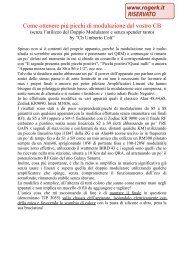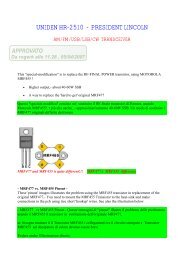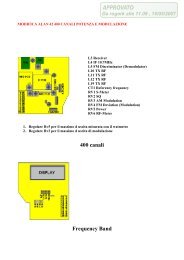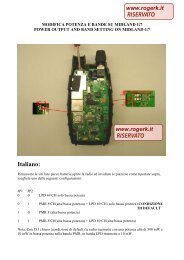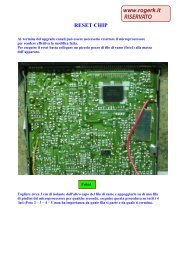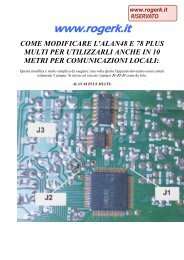Modifications for the ICOM - RogerK
Modifications for the ICOM - RogerK
Modifications for the ICOM - RogerK
- No tags were found...
Create successful ePaper yourself
Turn your PDF publications into a flip-book with our unique Google optimized e-Paper software.
was very useful. This feature is not documented in <strong>the</strong> manual.The radio is small. It's 2/3rds <strong>the</strong> height, width and depth of a Yaesu FT-736R. But <strong>the</strong>n it has no internal mains power supply,and nei<strong>the</strong>r will it accommodate two extra band modules like <strong>the</strong> Yaesu. It requires a 13.8 volt supply, about 16 amps, and issuitable <strong>for</strong> mobile operation. A microphone is not supplied and nei<strong>the</strong>r is a carrying handle.In England <strong>the</strong> combined cost of <strong>the</strong> radio and a PS-55 supply (GBP 245) is about GBP 1940; an FT736R from <strong>the</strong> same dealer isGBP 1700. GBP = Great British pounds sterling.The Hidden FeaturesBeing small <strong>the</strong>re are only 32 buttons and knobs on <strong>the</strong> front panel compared with 67 on <strong>the</strong> Yaesu, so <strong>the</strong> lesser used functions,about 20 of <strong>the</strong>m, such as dial dim, pre-amp feed control, RIT rate, CAT baud rate and so on are pre-stored via a configurationprocess. To invoke this requires <strong>the</strong> radio to be switched off and on again up to four times, which seemed unnecessarily clumsyto me. Some o<strong>the</strong>r functions are relegated to slide switches inside <strong>the</strong> radio, and adjustment requires you to remove <strong>the</strong> covers.This takes a few minutes. See later.Normal Tuning ManagementThe radio is organised around a Main Band and a Sub Band, each assigned to UHF or VHF or vice versa. You transmit on <strong>the</strong> Mainband only. You receive on both Main and Sub simultaneously. There are duplicated volume and squelch controls; Main appears in<strong>the</strong> left headphone, Sub in <strong>the</strong> right; an internal switch allows <strong>the</strong>se sounds to be mixed or separated. There is an internalspeaker and <strong>the</strong>re are two external loudspeaker sockets; smart wiring selects <strong>the</strong> expected sum/separated combinations.Storing, retrieving and swapping frequencies and modes is a doddle.Everything you could possibly expect is provided. Tuning rates are very sensible, and can be quickly adjusted from 1 MHz rightdown to 1 Hz resolution on SSB/CW, 100 Hz on FM. There are two VFOs each <strong>for</strong> VHF and UHF plus 100 tunable memoriesinitially apportioned 50/50 between VHF and UHF, but you can alter this up to 80/20 ei<strong>the</strong>r way.The idiom is a little different from <strong>the</strong> FT736R's, and took practice to acquire, but within a couple of hours became secondnature. I liked having both frequencies in view. The amber LCD display has very crisp characters and delights <strong>the</strong> eye.Because you transmit on Main and receive on Sub, and can control each quite independently, you can (and do) operate satelliteswhen in "normal" mode.Un<strong>for</strong>tunately RIT, passband Shift and optional CW-Narrow do not work on <strong>the</strong> Sub band, i.e. on <strong>the</strong> full-duplex receivefrequency. Nei<strong>the</strong>r do manual AGC fast/slow select nor <strong>the</strong> mechanical S-meter. Instead on Sub band, CW or SSB modeautomatically chooses AGC fast or slow <strong>for</strong> you, and <strong>the</strong>re's an LCD bargraph S-meter.Satellite Tuning ManagementWhen you enter "Satellite" mode ei<strong>the</strong>r <strong>the</strong> satellite VFO pair is used, or one of <strong>the</strong> 10 satellite memory pairs, or you can transfer<strong>the</strong> "Normal" frequency pair across (and back again when you leave).When in satellite mode, Main and Sub band frequencies track toge<strong>the</strong>r, ei<strong>the</strong>r normal or reverse - as <strong>for</strong> example with Oscar-13mode-B.Alas, <strong>the</strong>re is no proper "untrack" facility; to alter one frequency independently of <strong>the</strong> o<strong>the</strong>r you have to hold in one of twoalternative front panel buttons whilst turning <strong>the</strong> main tuning knob. With practice I managed sort-of using my thumb and<strong>for</strong>efinger <strong>for</strong> <strong>the</strong> main knob, and third or fourth finger <strong>for</strong> <strong>the</strong> buttons; left handers would find it nearly impossible. It's really atwo handed job, and is excruciatingly fiddly.I discovered an undocumented kludge that partially obviated this; using <strong>the</strong> microphone Up/Down buttons, only one frequencychanged. However <strong>the</strong> smallest step size from <strong>the</strong> mic buttons is 100 Hz. (See later).In fact, to tune TX and RX independently you need to adopt a change of attitude to <strong>the</strong> radio. Just <strong>for</strong>get all about a so-called"satellite" mode!Do your satellite operating in "normal", and only engage "satellite" when you want to do a quick bit of ganged tracking, orretrieve a frequency pair from <strong>the</strong> 10 satellite memories. I don't think this is how <strong>the</strong> designers envisaged things.Intriguingly <strong>the</strong>re is a blank button position actually marked Satellite, sandwiched between Normal and Reverse. I wonder whyit's not fitted and called "Untrack"? Perhaps once it was.As be<strong>for</strong>e, since satellite mode receive is on Sub band, passband Shift, CW-Narrow, manual AGC fast/slow select and mechanicalS-meter are inoperable, but a RIT has been provided. (Does anyone ever use RIT?)It would have been far, far better if <strong>the</strong>re were a genuine "satellite" mode with Main receive and Sub <strong>for</strong> transmit. Main has <strong>the</strong>larger digits which are square in <strong>the</strong> middle of <strong>the</strong> radio and it's clearly <strong>the</strong> object of your visual, mental and operating focus.And of course Main has all <strong>the</strong> RIT/SHIFT/CW-N/AGC/METER controls working <strong>for</strong> it.I really wish I didn't have to say this, but "satellite" mode looks at best to be an afterthought grafted on because <strong>the</strong> controlmicroprocessor makes it easy. "It's only software".




